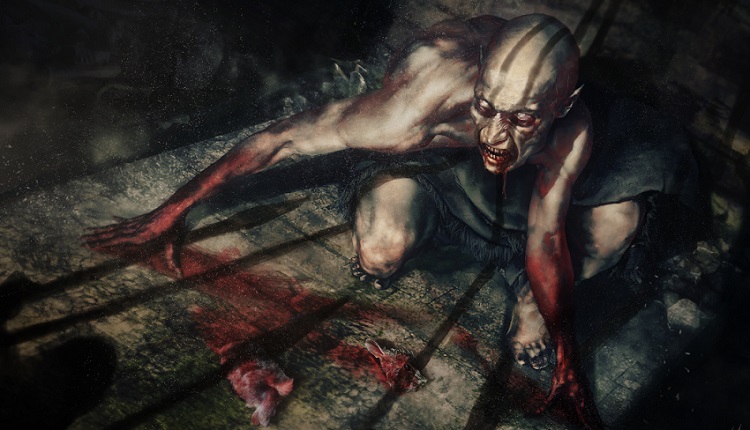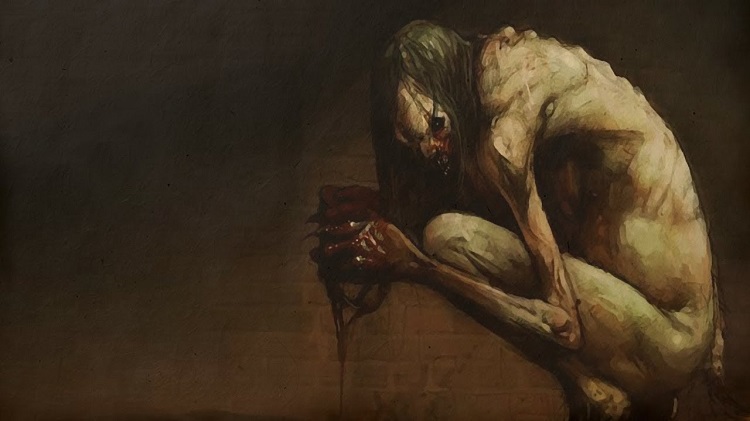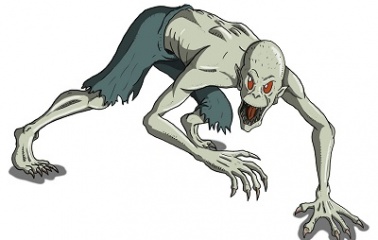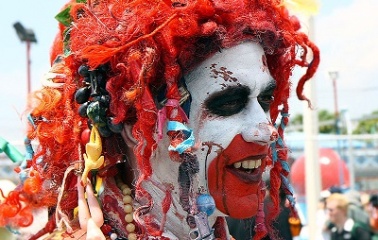You watch in terror as a pack of white humanoid figures rush towards you. Your feeling of dismay grows stronger as the woman by the fire begins to undergo a transformation that reveals her to be another one of the beasts. A sinking feeling grows in your chest as you remember the warnings to avoid traveling these parts at night, but it is too late. The Ghouls are upon you.
What is a Ghoul?
A ghoul is a creature that appears from Arabic mythology. It is thought that ghoul’s have their roots in Mesopotamian religion and mythology because they have similar traits to gallu demons. It is thought that the connection comes from the nomads of Arabia interacting with the Mesopotamian civilization and trading stories. The gallu demons were known to be part of the underworld and were thought to carry their victims off to the land of the dead to devour them. Ghouls of Arabic mythology have very similar characteristics.

Regardless of how the ghouls came to be in Arabic lore, it is known that much of what is known of these creatures comes from the work ‘Arabian Nights.’ This series of stories provides an interesting perspective on these creatures and where they come from. Additionally, it is important to note that the translation of Arabian Nights by European authors wasn’t entirely true to the nature of the stories that were recorded in the work. Because of this, ghouls were transformed in a way that lead to many modern interpretations of the creature.
The overlap of the two perspectives tends to agree that ghouls are humanoid creatures and tend to frequent areas that are largely abandoned by humans – like cemeteries. They were known to eat flesh and drink blood – though surprisingly the source of these things differs depending on which version of the legend you follow.
Early Arabic Ghouls
The earliest stories of the ghouls emerge from Arabic legend. The myth of the ghoul predates Islam, but because the ghoul is mentioned in the Koran the creature is still a source of terror in Arabic culture today. There are several theories as to why the ghoul makes an appearance in the Koran. Some hypothesize that the widespread belief of Jinn (creatures responsible for the genie myths that are thought to inhabit a parallel world) lead to the implementing of the ghouls in Islamic religion naturally. Others believe that early practitioners of Islam used stories that were familiar to their culture in order to convert people to their new beliefs. Regardless of how ghouls were introduced into Arabic lore, there are several key facts that remain prominent in the early ghoul legends.
One of the most important facts that is covered by early ghoul mythology is that these creatures appear to be born of Iblis (the Islamic equivalent of Satan), which technically makes them jinn. Iblis was thought to be part of a race of creatures called jinn – creations of Allah who lived in a world that was set apart from ours. However, even though they were part of a different world, they were still capable of interacting with ours. It is thought that when Allah created man, Iblis became jealous that man was favored more than his kind and refused to bow before him. He would have been killed for his crime, but his life was spared by Allah until Judgement Day. Unfortunately, Iblis is using this time to take his vengeance on humans. This is likely why the creation of ghouls is credited to Iblis. After all, a creature who feeds on the flesh of humans and delights in their torture is a likely form of revenge from a fallen jinn.
Ghouls of early Arabian lore were also known to dwell in deserted areas. People who traveled near cemeteries and abandoned buildings or through desert wastelands were warned to be especially vigilant against these creatures. They were thought to be bipedal – though with a hunched form – and were known to crawl (and sometimes run) on all four limbs like an animal. They were most fond of feeding on young children (presumably because of the ease with which they could be killed) but would feed off of any human they had the chance to cannibalize.
Ghouls were also thought to have the ability to shapeshift. They could appear as beautiful women that preyed on lustful men by luring them to a secluded area, or as an animal in the desert like a hyena. They were known to stay in these forms until they had a chance to pounce on their victim and devour them. Ghouls were thought to be especially fond of preying upon travelers (solo travelers or small groups in particular). Some stories claim that they lit fires off of well-traveled paths so they could lure a single traveler into a trap and devour them.
Another interesting feature of the ghouls of early legends is that they were not particularly associated with eating the dead. They were known to prefer fresh meat, and while they didn’t turn down a corpse if there was no other available food source, they certainly preferred a live victim. They were also known to enjoy drinking blood and stealing coins. Early ghouls were also known to carry disease on their skin, which could have been because of the types of places they were thought to inhabit.
Ghouls in European Legends
Ghouls were largely unknown to Europe until Antoine Galland (a French writer) translated “The Thousand and One Nights” (also known as Arabian Nights). While the translation of the text was a wonderful venture into the rich Arabic culture, the texts were tainted because of Galland’s loose interpretation of the texts. In fact, he is thought to have created several characters and added in stories that were not originally part of the work. One of these characters was Amina – a woman who enjoyed keeping company with ghouls inhabiting a graveyard instead of spending time with her new husband. This version of ghouls introduced the idea that the creatures frequented graveyards specifically to feast on the dead – which in turn had a large impact on how Europe grew to perceive the ghoul legend.

The ‘Arabian Nights’ text continued to grow in popularity across Europe and, in turn, inspired many stories of the ghoul that affected the modern day interpretation of the creature. Some of the most famed writers of history were inspired by these legends and would eventually add their own perspective of the creature and its motivations.
What do Ghouls Look Like?
The physical appearance of a ghoul is similar in both Arabic and European portrayals of the creature, though there are some noticeable differences that should be taken into account.
Ghoul Appearance According to Early Arabic Lore
In many early myths, there are descriptions of ghouls who are quite hairy. This is possibly because they are known to have canine features. Having an appearance that is similar to a dog, it would be natural to conclude that the rest of the creature’s appearance would have been animal-like.
However, it is also important to note that there are ghouls in these early myths that hold the power to shape shift. They are known to transform into beautiful women that lead men astray and into secluded areas. When the man was properly distracted, the ghoul (and sometimes its pack) would pounce on the lustful men and devour them.
There are also accounts of ghouls who would transform into other animals. While it was possible for a ghoul to transform into any type of animal, it seems that a popular choice was for it to transform into a hyena. The ghoul would use the form of the hyena to lure a person into the desert. When they were far enough away from civilization, the rest of the pack would appear and pounce upon the victim. They would then devour the victim quickly.
It is also important to note that in addition to having a canine-like face, early ghouls were also thought to have humanoid bodies and hoof-like feet. These were characteristics that were used to identify the presence of ghouls – the hooves especially. It was said that when a ghoul was nearby, the hoof-like imprints of the creatures would be easy to spot. It was also characteristic to identify a ghoul by seeing a humanoid figure in the distance that suddenly got down on it’s hands and feet to scurry away. Ghouls were known to prefer crawling on all fours, even though they were capable of walking on two feet.
Ghoul Appearance According to Europeans
European descriptions of ghouls are interesting in that they are still similar to the ghouls of Arabic folklore in some senses, while in others they have changed entirely.
The new ghouls still maintained their canine features and their hooves, but instead of presenting a hairy exterior, they transformed into pale creatures that had a skin that looked rubbery in appearance. These creatures are reported to be sensitive to light, though not to the same extent as vampires. Even though the light can cause them pain, it cannot kill them.
In addition to being pale, these modern ghouls are also capable of shape shifting. An interesting feature, however, is that these ghouls seem to have even greater shapeshifting abilities than the early ghouls. Recent literature has grown to suggest that ghouls are able to shapeshift into the form of the last victim they have devoured, regardless of whether the human was alive or dead when they feasted on their flesh. Additionally, it has been suggested that these ghouls can also access the memories of the person they devoured by eating their brain, effectively allowing them to blend into society without being discovered.

Lastly, it is suggested that although some ghouls have a rather fierce and grave appearance, others are capable of blending into human society fairly well. Changelings are switched with human children at birth and grow up in human households unnoticed. It is uncertain if the Changeling’s features are less harsh because they grow up in an environment that is less harsh and evil than what they were born into or because they are just genetically predisposed to have more humanistic traits. Either way, they are able to pass with relative ease.
Where do Ghouls Live?
Ghouls tend to live in isolated areas that are apart from the majority of society. They can frequently be found in desert wastelands, abandoned buildings, and cemeteries. However, contrary to common beliefs, a ghoul does not necessarily prefer to reside in a cemetery because they seek to eat corpses – they just appreciate the seclusion.
More recent tales of ghouls suggest that the creatures have moved their operations largely underground. They are said to frequent basements and cellars in abandoned buildings, and are even rumored to have an underground network of tunnels that they use to travel. They may also have connections to the subway and are thought to sometimes eat the remains of subway crash victims before paramedics arrive.
Can a Ghoul Be Killed?
There are ways to fight off a ghoul – though it is important to be very precise. Any mistake on the part of the individual fighting a ghoul will certainly result in death.
The most common method used for killing these creatures is decapitation. Ancient ghoul myths claim that a ghoul can be killed by using a sword. It is imperative, however, that the attacker only use one blow to kill the beast. Two or more strikes will resurrect the creature and almost certainly spell out death for the person fighting the ghoul. Because only one strike can be used to kill a ghoul, decapitation is the preferred method to ensure that the beast dies quickly.
More recent mythology tells us that there are several other ways that a ghoul can be dealt with. One of these methods is the use of fire. Using fire can be tricky however, as you will have to be able to heat the element to extreme temperatures to char the ghoul to ashes.
It is also thought that electrocution and exposure to concentrated acids can kill ghouls. This has to be done thoroughly – if a ghoul is not dead it could possibly regenerate itself and come back to finish you off.
Lastly, although light is not fatal to ghouls, it is worthwhile to mention that sunlight is painful to ghouls and more concentrated types of light can be especially harmful to their eyes.
Famous Ghouls in Literature
From the original tales of ghouls that were written in Arabic literature up to the modern day interpretation of these creatures, there have been many authors that have recorded the legend of the ghoul.
The History of Gherib and His Brother Agib
‘The History of Gherib and Hist Brother Agib’ is a story that appears in ‘The Thousand and One Nights’ and is one of the original stories that features ghouls that wasn’t tampered with by Antoine Galland.
In ‘The History of Gherib and His Brother Agib’ , Gherib is sent on a journey in order to obtain the hand of his love, Mahdiyyaa, in marriage. Along the way, he encounters Sa’dan the Ghoul – the master of a castle he must overcome in order to continue on his quest. He defeats the Ghoul and his sons and converts them to Islam.
Sa’dan the Ghoul is described as a cannibal, making it appear that he had, at the very least, some human features.
The Nameless Offspring
‘The Nameless Offspring’ is a short story that was written by Clark Ashton Smith in 1932. It was likely inspired by ‘The Thousand and One Nights’ and would go on to add some interesting myths to the legend of the ghoul.
‘The Nameless Offspring’ stays true to the ghoul legend in that it doesn’t change the supposed abode of these creatures (cemeteries) and that it doesn’t try to change the features of the creature. It is still shown to have pale, whitish skin, a face with features that resemble a canine animal, long claws, and feet that are hoof-like. It does reference a ghoul’s preferred meal of corpses, but that is to be expected as Clark Ashton Smith was influenced by European translations that had been altered by Galland.
What is interesting about this particular text, is that it offers a hypothesis as to how these creatures were able to survive. It is proposed that ghouls mate with humans who have been mistakenly buried, but that their offspring remain ghouls and do not appear to be hybrids. This idea went on to inspire many who studied the ghoul legends.
Pickman’s Model
‘Pickman’s Model’ is a short story on ghouls that was written by famed author, H. P. Lovecraft. This piece details a man’s encounter with an artist named Pickman who has taken up a fascination with the idea of ghouls and fiendish creatures.

The text goes on to describe the many paintings that Pickman has created. In the end, it is suggested that Pickman himself is something other than human (likely a changeling) and that ghouls still exist with humanity in the subways and forgotten underground tunnels.
This story makes references to ‘The Nameless Offspring’ by Clark Ashton Smith, and also proposes some alternative ideas for how ghouls are able to procreate. This theory suggests that ghouls steal human children and replace them with their own to allow for genetic diversity. The ghoul offspring (referred to as changelings) appear to be human, but have several characteristics that make them appear to be something other than mortal.
How Are Ghouls Created?
There are many theories as to how ghouls are created, though many have simply been born of imagination and observation of the ghoul’s behavior.
Standard Procreation
One of the most simple explanations for how a ghoul could come into being is simply the mating of a male and female ghoul. This would be the simplest explanation, though oddly enough it doesn’t seem to be the most frequently used in mythology. Instead, it seems that most ghouls who procreate together have a tendency to eat their young soon after birth. This could be a result of weak genetic diversity – a problem that several other hypotheses seek to explain.
Ghoul Hybrids
There were some theories that arose in ghoul mythology that claimed that these creatures could mate with humans – often humans who had been mistakenly buried. In this manner, ghouls were able to keep stronger human genes in their own gene pools and continue to create offspring.
Descent into Ghouldom
There are some who theorize that ghouls are so difficult to destroy entirely because they don’t actually procreate – instead, they are former humans who have transformed into ghouls because of their evil nature. There are several ways that this could have been done. The first is when a person lives a life that is so evil that their actions cause them to rise from the dead and live as a ghoul. The second occurs when a human cannibalizes another person. Both of these transformations are permanent and reflect the loathsome soul of the afflicted person-turned-ghoul.
Outbreak
Finally, there are those who believe that ghouls are created by some sort of genetic abnormality – something that could possibly occur through an infectious disease. This process is usually transmitted when a person is bitten by a ghoul or comes into contact with biological fluids that seep into the skin. This causes the afflicted person to gradually turn into a ghoul, or die and then return from the dead as a ghoul.
Origin of the Ghoul Myth
It is likely that the myth of the ghoul has its roots in Mesopotamia. There is also a possibility, however, that the ghoul myth arose to give an example of the wrath of Iblis when he realized he would not be allowed to enter paradise because he refused to submit to man.
Because ghouls tend to target travelers and lustful men, the ghoul story could have also been used to explain the sudden disappearance of a person – whether they had died or simply run off with another woman.
It is also worthwhile to note that ghouls are said to carry sickness on their skin. This could be symbolic. The creatures are known to inhabit abandoned buildings and cemeteries. It is possible that the ghoul myths were created to keep people away from areas that were more likely to hold germs and viruses that would be deadly to large populations. This could have helped to keep large civilizations healthy by keeping citizens out of areas that were more likely to be contaminated.









